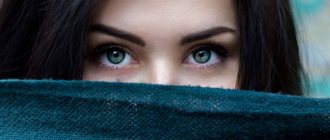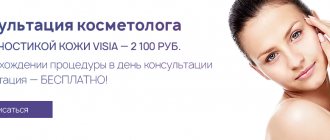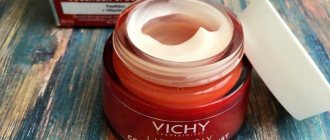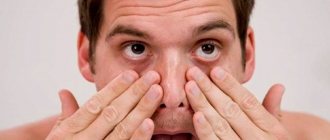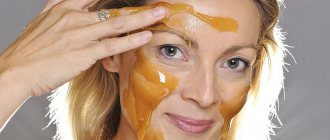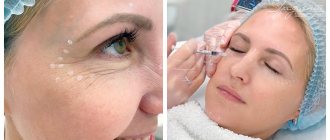In the modern world there are almost no women left who have not heard about Botox. One of the most popular ways to use it is by injection into the area around the eyes to smooth out crow's feet. This is where the skin is thinnest and most delicate, and expression lines appear first. Already at the age of 25-27, girls decide to take the dangerous path of so-called Botox rejuvenation, which sucks in like a quagmire and turns beautiful faces into ugly masks. This is partly to blame for the lack of awareness about the insidiousness of this procedure, which only seems effective. Cosmetologists don’t tell the whole truth about botulinum poison. We bridge knowledge gaps.
Age-related changes in facial skin
With age, facial skin begins to age and fade - it loses moisture, elasticity and turgor. The first changes can be observed as early as 25 years of age. First, dynamic wrinkles appear, which are also called facial wrinkles, because they form on facially active areas of the face (forehead, between the eyebrows, the area around the eyes). Over the years, they turn into deep, static creases and folds. In people with active facial expressions, the first wrinkles may appear even before the age of 25.
The mechanism of wrinkle formation lies in structural changes in the skin and muscular transformations. The skin loses strength and elasticity due to a reduction in the main components of youth: collagen, elastin, some fats, water. And the muscles spasm from overexertion, that is, they literally become shorter. And here is the result: the skin folded into an accordion.
Often, facial wrinkles appear earlier than others on the face near the outer corners of the eyes (“crow’s feet”) and on the lower eyelid. The skin in this area is delicate and quickly becomes covered with grooves and folds. To do this, simply smile and squint often.
It is believed that in 25% of cases the skin ages naturally, and in 75% the process is accelerated due to external factors: poor climate, poor diet, cosmetics, stress.
As a rule, by the age of 30, women are already looking for ways to get rid of wrinkles - the cult of youth, fashion and modern trends make us ashamed of our age and age-related changes. Because of this, in recent years even 20-year-old girls have been thinking about Botox. And this is just a disaster! And cosmetologists are unlikely to dissuade them and tell them the whole truth about this unnecessary and destructive procedure. And formally, contraindications to Botox injections exist only for persons under 18 years of age.
Why is Botox done under the eyes?
Almost every woman, regardless of age, wants to remain beautiful and well-groomed. When she sees the first wrinkles in the mirror, she begins to panic, goes through options for rejuvenation and, in general, is ready to give everything she can just to somehow reverse the aging process.
And then cosmetologists appear with their “magic” procedure for instantly smoothing out wrinkles using Botox injections.
What age-related changes in the area around the eyes are proposed to be solved with Botox:
- wrinkles near the outer corners of the eyes (“crow’s feet”) and in the lower eyelid area,
- swelling and bags under the eyes,
- drooping (ptosis, drooping) of the upper eyelids,
- low location of eyebrow arches.
But what does the client get as a result, and at what cost?
How much does Botox around the eyes cost?
In the modern cosmetology department of the Neomed clinic, the cost of the Botox rejuvenation procedure is 300 rubles per unit of the drug. Since the dose required for correction is determined individually, the cost of the procedure will also vary in each specific case. In addition to affordable prices and a wide range of Botox rejuvenation services, our clinic offers the services of highly qualified specialists and the use of high-quality botulinum toxin preparations.
Find out the cost of the Botox procedure
What is Botox
Botox is a drug based on botulinum toxin, a powerful poison of natural origin. It is a protein toxin produced by bacteria. Literally translated as "sausage poison", as it was discovered as a result of fatal food poisoning from spoiled sausage.
Man learned to produce botulinum poison artificially as a biological weapon, and then this development was put into use by doctors, followed by cosmetologists.
Botulinum toxin is a neurotoxin, that is, a poison that has a neuroparalytic effect. It blocks the production of acetylcholine, which ensures the transmission of nerve impulses to the muscles, causing them to be paralyzed. In medicine, this ability of botulinum toxin to affect muscles is used to correct various involuntary muscle spasms and movement disorders. Botox is especially common in ophthalmology and in the treatment of cerebral palsy.
What is important to know about the use of Botox in cosmetology? It does not eliminate the cause of aging, but only creates a temporary effect of smoothed and tightened skin for 2-5 months. This is not a means of rejuvenation! Botox deprives the muscle of its natural function of contracting, which is why the skin appears to smooth out. But the structure of the dermis does not change, the lost elasticity and strength do not return. The muscle is simply affected and then does not even fully recover.
Moreover, Botox accelerates the aging process of the skin. A paralyzed muscle will not completely return to its original state (although cosmetologists talk about its complete restoration). And, what’s even worse, when the muscle affected by botulinum poison stopped functioning, other neighboring muscles began to work for it. This led to their overstrain, loss of healthy tone and correct configuration of the muscular system. The result is new wrinkles on the face that were not there before the Botox injection.
Preparations containing botulinum toxin
Botox is commonly called any drug containing botulinum toxin. But in the strict sense of the word, Botox is the trade name of the first drug based on botulinum toxin. It was released by Allergan from the USA about 30 years ago. Having realized how profitable this business is, several more manufacturers from different countries began to produce analogues of Botox. All drugs contain the same active ingredient - botulinum toxin type A (BTA), produced at one time as a bacteriological weapon. The products differ in different concentrations of BTA, composition of excipients, particle size, duration of effect and a number of other parameters.
Botox
Botox is the first and most popular remedy among botulinum toxin-based drugs. This product from America was registered in Russia in 1994. In addition to BTA, Botox contains albumin and chloride, which should limit the diffusion of the poison, that is, its spread beyond the target. But this does not stop the toxin from spreading under the skin, which is why the face takes on an unhealthy shape. Botox is considered to contain a moderate dose of botulinum toxin and is of moderate potency. The initial effect appears on the 4-7th day and reaches its maximum after 2 weeks.
Dysport
Dysport is the main competitor of French-made Botox. Unlike Botox, Dysport has a 2.5-3 times lower dosage of BTA, but it is also about 2.5 times cheaper. Given the need to administer more units of Dysport, the cost of these drugs is comparable. If you need 10-20 units of Botox for crow's feet, 30-60 units for Dysport. Dysport acts stronger and longer than Botox, since its active particles are smaller and contain less albumin, which is designed to stabilize BTA molecules. All this indicates that Dysport has higher diffusion, that is, it spreads more actively beyond the target. The initial effect occurs faster than Botox: within 1-4 days from the date of the procedure.
Botulax
Botulax is a drug from South Korea, the country that produces the largest number of products competing with Botox. In terms of its composition, Botulax is almost a complete analogue of Botox, but cheaper. Accordingly, all their characteristics are almost identical, as are the consequences. It is noted that the duration of action of Botulax is somewhat shorter than Botox. There is also information that the use of the Korean drug is accompanied by more pronounced discomfort.
Relatox
Relatox is a Russian-made drug that entered the market in 2012. Cheaper than foreign drugs. It is positioned as an analogue of Botox, which begins to act faster and the effect of which lasts longer. But in many ways, this activity of Relatox is explained by the multiple smaller size of its particles: its molecular weight is 6 times lower than that of Botox. Therefore, it acts faster and seemingly more evenly on the target muscle, but at the same time it penetrates more actively into other muscles (strong diffusion), which is fraught with side effects. Also, unlike Botox, Dysport and Botulax, Relatox does not contain albumin, a stabilizing protein that inhibits the diffusion of poison and softens its effect. There are many reviews on the Internet about the poor quality of Relatox and the pain of its administration.
Xeomin
This is a German drug that contains botulinum toxin of the highest purity, therefore it is supposedly safer than its analogues, but also more expensive. The action comes a little faster than Botox and Dysport, but also ends earlier. Like the Russian Relatox, the molecular weight of Xeomin is very low, which indicates, on the one hand, a more uniform distribution of the drug, and on the other hand, a high ability to spread beyond the injection zone. But the diffusion of Xeomin is inhibited by the stabilizer albumin, which is even more abundant in the German drug than in Botox. It is believed that the effect of Xeomin is softer, without the “stony face” effect. It differs from its competitors in that it can also be stored at room temperature.
Lantox
A cheaper Chinese analogue of Botox, comparable in dosage and molecular weight, but does not contain albumin, which inhibits diffusion. Instead of albumin (human immunoglobulin), Lantox contains gelatin of animal origin, the task of which is the same: to impart stability to the botulinum toxin molecule and prevent excessive diffusion. The effect of Lantox is average in strength between Botox and Dysport.
Stages of the botulinum therapy procedure
Consultation with a cosmetologist
The specialist will examine you, identify problem areas on your face and neck, and clarify what medications you are currently taking. After this, the doctor will ask you to perform your usual facial movements (smile, frown) to determine the Botox injection points. Next, the drug and its dosage are selected.
Skin cleansing
Before starting the injections, the doctor will ask you to take a comfortable reclining position on the couch and perform cleansing treatments for your face and neck. If necessary, lidocaine gel is additionally applied to the skin, which has a local anesthetic effect.
Botox injections
The procedure takes from 10–15 minutes to one and a half hours, depending on the amount of work. It takes several minutes to treat one area. The injections are performed with disposable insulin syringes with very thin needles, so there are no traces left after them. You can get injections even during your lunch break.
Recovery
After Botox injections, it is not recommended to take a horizontal position or bend over for 2 hours. The first results will be noticeable after 2-3 days, and the final effect will be visible after 2 weeks. Different muscles require different amounts of time to settle into a relaxed position.
Skin care after the procedure
Botox injections are safe and well tolerated. However, there are restrictions that should be followed in the first 10 days after the injections. In particular, intense training and warm-up procedures help remove botulinum toxin from the body, reducing its effect.
What not to do in the first days after the procedure
- sleep on your stomach with your face touching the pillow;
- actively engage in sports;
- wear tight hats that tighten the skin of the forehead;
- massage your face and apply ice to it;
- wash your hair with hot water;
- visit a bathhouse or sauna;
- use cosmetics containing glycolic acid and retinol.
How does the Botox procedure work under the eyes?
Typically, the Botox injection procedure follows the same scenario, regardless of the area of the face being treated. With injections into the area around the eyes, the sequence of actions is as follows:
- The cosmetologist asks the patient to smile, make a sad face and express other emotions to identify problem areas.
- Areas for injections are marked on the face. Four points are selected: two points near the outer corner of the eyes and one each near the tip of the eyebrow and in the area of the bone border.
- A special anesthesia is applied to the face.
- The drug is administered using thin needles.
- After the injections, the patient lies down for 10 minutes.
Drug differences
The principles of action of the drugs are different - Botox affects muscle activity, while hyaluronic acid replenishes the lack of substance in the injection areas.
The difference between Botox and hyaluronic acid also appears in the areas of application. Botox injection is indicated only in the forehead and eyes; in other areas it can distort facial expressions. Hyaluronic acid can be used in any segment of the face.
Conclusion: botulinum therapy corrects only facial wrinkles that arise due to incorrect functioning of the facial muscles. Other age-related changes are corrected by other methods, in particular, injections of hyaluronic acid.
How long does it take for wrinkles to smooth out after Botox?
The visual effect of Botox injections appears 3-4 days after the procedure and reaches its maximum by the end of the second week. Some manufacturers promise visible results in just one day.
Waiting for change is accompanied by many troubles. As a rule, you have to put up with bruises and unevenness on your face for the first week. Your hands feel like the skin is falling inward. Often the face swells and additional folds appear that were not there before. You should not laugh or frown a lot, so as not to provoke wrinkles.
Often the effect after one procedure turns out to be such that it needs to be corrected. And this is a new trip to the cosmetologist and new portions of poison.
Features of the eye treatment for crow's feet
Botox injections into the corners with a very thin needle cause almost no pain, with the exception of patients with hypersensitivity. The dosage and technique of administering the toxin is selected by BioSpaClinic doctors individually, taking into account the characteristics of the problem, the condition of the skin, age, and a history of chronic diseases.
The manipulation does not require a rehabilitation period; the drug enters the muscle fibers and immobilizes them. The effect of botolutoxin lasts from 4 to 6 months.
It is not recommended to inject it if there are the following contraindications:
- pregnancy;
- herpes in the active stage;
- inflammatory skin diseases;
- oncology;
- myasthenia gravis;
- blood diseases.
BioSpaClinic specialists will help patients of all ages get rid of imperfections in appearance, take into account possible health risks and use the most effective injection drugs.
Pros and cons of Botox under the eyes
If your goal is to get rid of wrinkles, then Botox is definitely not your option. Botulinum poison does not remove wrinkles. It gives a temporary effect due to muscle paralysis and does not in any way solve the problem of skin losing elasticity and strength. Botulinum toxin only works on facial wrinkles and does not affect deep ones.
And we haven’t yet talked in detail about the dangers of botulinum toxin and the mass of ugly side effects! The disadvantages of Botox injections under the eyes, like any other botulinum therapy procedure, can be listed endlessly. Judge for yourself. Botox under the eyes is:
- A blow to facial expressions and beauty.
The face loses facial expressions and becomes stony. At best, you won't be able to express your emotions. At worst, a paralyzed person will replace some emotions with others. It will seem to others that you are wincing in disgust, although you are smiling at that moment. Or you will seem angry when you are surprised by something. In addition, various side effects may occur on the face - a very common occurrence. This could be ptosis (drooping) of the upper eyelid, swelling, bruising, facial distortion, new wrinkles, and the like (read details in the next chapter). - Bad feeling.
After Botox, the injection areas often cause headaches. Fever, vomiting, dizziness and other health problems also occur. - Danger.
Since botulinum venom has diffusion, that is, it spreads beyond the injection zone, it can cause various complications in the eyes and not only. - Acceleration of aging.
Botox accelerates age-related changes. Paralyzed muscles do not fully recover, and the neighboring muscles that worked for them wear out faster. As a result, not only the wrinkles exposed to the poison return, but also new ones appear. - Botox addiction.
When, several months after Botox injections, the effect of the drug stops, the patient goes for a new portion of the poison. This happens over and over again. An addiction to botulinum toxin develops. The frequency of visits and dosages are increasing. Appearance is disfigured, health is undermined.
Are there any benefits to Botox under the eyes? In cosmetology - no. Only an illusion that turns into terrifying consequences. Even in medicine, where the use of Botox is justified for therapeutic purposes, this drug is feared. According to neurologists, the consequences that botulinum toxin can lead to have not yet been sufficiently studied.
Preparing for Botox injections
There is no need to prepare specially for visiting a cosmetologist. In order to eliminate the risk of side effects, it is recommended to stop drinking alcohol about a week before the procedure. If you are taking medications, you should also inform your cosmetologist about this.
What should you not do before the procedure?
- drink alcoholic beverages;
- take antibiotics and anticoagulants;
- drink calcium containing medications;
- apply decorative cosmetics.
Consequences and side effects of Botox under the eyes
But there are many known consequences of Botox that botulinum toxin treatment victims experience everywhere. We are especially interested in the side effects that occur after injections of botulinum venom into the area around the eyes. Let's name the main ones:
- Dry eyes and skin tightness.
Lasts several days in most patients. - Bruises, hematomas.
Capillaries are injured during injections in everyone, which is why bluish dots appear on the face, and often even ugly hematomas. The story may drag on for several weeks. - Pain when touching the eyes.
- Ptosis (drooping) of the upper eyelid.
Happens frequently. Occurs due to uneven distribution of botulinum toxin. The extreme form is the inability to open the eye. For the problem to disappear, it will take more than two months to completely remove the poison from the body. - Headache.
They may bother you for up to two weeks or more. - New wrinkles.
They arise due to the fact that neighboring muscles, trying to replace atrophied ones, worked in an increased mode and spasmed. - Severe swelling.
Due to unhealthy muscle tone, lymph flow is disrupted, resulting in swelling. It can be pronounced and not go away for a long time. - Facial asymmetry.
In the case of Botox in the area around the eyes, it usually appears in the form of asymmetrical eyebrows: one raised, the other lowered, and so on. - Eye pathologies.
Due to damage to non-target areas by the drug, eye complications may occur: paralysis of the eye muscles, anisocoria of the pupils (different sizes), mydriasis (pupil dilation), strabismus, blindness. - Allergy.
It occurs due to both botulinum toxin and auxiliary components. Possible anaphylactic shock.
What do products “with the Botox effect” help with?
Marketing strategy today is almost the main engine of trade, so it is no longer surprising to see facial skin care products with the so-called “Botox effect” on store shelves. In advertising brochures they are recommended as an alternative to injections and are assured of almost magical properties. But the composition of such products is far from what is included in the injections. Advertised products usually contain muscle relaxant peptides (argireline, matrixyl, octamoxyl), which can slightly relax facial muscles. The skin will indeed smooth out a little, which has been proven by clinical experiments, but such products are far from the effect of injections.
Experts' opinion
There are many forums on the Internet where cosmetologists can communicate with each other. Go to them and read what experts really think about Botox. Here are just a few statements:
Botulinum toxin is poison. A person is already exposed to the influence of harmful substances, and during the procedure he voluntarily agrees to the introduction of a toxin
(Alexey, cosmetologist with 15 years of experience, Voronezh)
The drug is addictive – physical and psychological. Under the influence of botulinum toxin, the muscles relax. After the drug wears off, the situation gets worse. From a psychological point of view, a person gets used to a smooth face, so even small wrinkles make him want to urgently inject botulinum toxin
(Nikita Yashin, young specialist in the field of cosmetology, Moscow).
There is a high risk of medical errors. There are very few experienced cosmetologists whose hands do not tremble. If the doctor injects into a point that is only a couple of millimeters away from the desired point, the result may be hopelessly spoiled
(Anton Laptev, cosmetologist in a private clinic, Samara).


